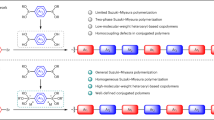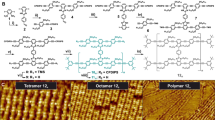Abstract
Control of intermolecular interactions1 is crucial to the exploitation of molecular semiconductors for both organic electronics2 and the viable manipulation and incorporation of single molecules3 into nano-engineered devices. Here we explore the properties of a class of materials that are engineered at a supramolecular level4,5,6,7,8,9,10 by threading a conjugated macromolecule, such as poly(para-phenylene), poly(4,4′-diphenylene vinylene) or polyfluorene through α- or β-cyclodextrin rings, so as to reduce intermolecular interactions and solid-state packing effects that red-shift and partially quench the luminescence11. Our approach preserves the fundamental semiconducting properties of the conjugated wires, and is effective at both increasing the photoluminescence efficiency and blue-shifting the emission of the conjugated cores, in the solid state, while still allowing charge-transport. We used the polymers to prepare single-layer light-emitting diodes with Ca and Al cathodes, and observed blue and green emission. The reduced tendency for polymer chains to aggregate allows solution-processing of individual polyrotaxane wires onto substrates, as revealed by scanning force microscopy.
This is a preview of subscription content, access via your institution
Access options
Subscribe to this journal
Receive 12 print issues and online access
$259.00 per year
only $21.58 per issue
Buy this article
- Purchase on Springer Link
- Instant access to full article PDF
Prices may be subject to local taxes which are calculated during checkout




Similar content being viewed by others
References
Cornil, J., dos Santos, D.A., Crispin, X., Silbey, R. & Brédas, J.L. Influence of interchain interactions on the absorption and luminescence of conjugated oligomers and polymers: a quantum-chemical characterization. J. Am. Chem. Soc. 120, 1289–1299 (1998).
Cacialli, F. Organic semiconductors for the new millennium. Phil. Trans. Royal Soc. Lond. A 358, 173–192 (2000).
Liang, W., Shores, M.P., Bockrath, M., Long, J.R. & Park, H. Kondo resonance in a single-molecule transistor. Nature 417, 725–729 (2002).
Gong, C. & Gibson, H.W. in Molecular Catenanes, Rotaxanes and Knots (eds Sauvage, J.-P. & Dietrich-Buchecker, C.) 277–321 (Wiley-VCH, Weinheim, 1999).
Collier, C.P. et al. Molecular-based electronically switchable tunnel junction devices. J. Am. Chem. Soc. 123, 12632–12641 (2001).
Raymo, F.M. & Stoddart, J.F. Interlocked macromolecules. Chem. Rev. 99, 1643–1663 (1999).
Nepogodiev, S.A. & Stoddart, J.F. Cyclodextrin-based catenanes and rotaxanes. Chem. Rev. 98, 1959–1976 (1998).
Zhu, S.S. & Swager, T.M. Conducting polymetallorotaxanes: Metal ion mediated enhancements in conductivity and charge localization. J. Am. Chem. Soc. 119, 12568–12577 (1997).
MacLachlan, M.J., Rose, A. & Swager, T.M. A rotaxane exciplex. J. Am. Chem. Soc. 123, 9180–9181 (2001).
Gadret, G. et al. Optical and electroemission properties of thin films of supermolecular anthracene-based rotaxanes. Appl. Surf. Sci. 175, 369–373 (2001).
Cornil, J., Heeger, A.J. & Brédas, J.L. Effects of intermolecular interactions on the lowest excited state in luminescent conjugated polymers and oligomers. Chem. Phys. Lett. 272, 463–470 (1997).
Burroughes, J.H. et al. Light-emitting diodes based on conjugated polymers. Nature 347, 539–541 (1990).
Kraft, A., Grimsdale, A.C. & Holmes, A.B. Electroluminescent conjugated polymers — seeing polymers in a new light. Angew. Chem. Int. Edn 37, 402–428 (1998).
Cardin, D.J. Encapsulated conducting polymers. Adv. Mater. 14, 553–563 (2002).
Shimomura, T., Akai, T., Abe, T. & Ito, K. Atomic force microscopy observation of insulated molecular wire formed by conducting polymer and molecular nanotube. J. Chem. Phys. 116, 1753–1756 (2002).
Buey, J. & Swager, T.M. Three-strand conducting ladder polymers: two-step electropolymerization of metallorotaxanes. Angew. Chem. Int. Edn 39, 608–612 (2000).
Lagrost, C. et al. Host-guest complexation: a convenient route to polybithiophene composites by electrosynthesis in aqueous media. synthesis and characterization of a new material containing cyclodextrins. J. Mater. Chem. 9, 2351–2358 (1999).
Vidal, P.L. et al. Conjugated polyrotaxanes containing coordinating units: reversible copper(I) metallation–demetallation using lithium as intermediate scaffolding. Chem. Commun. 629–630 (1998).
Taylor, P.N. et al. Insulated molecular wires: synthesis of conjugated polyrotaxanes by Suzuki coupling in water. Angew. Chem. Int. Edn 39, 3456–3460 (2000).
Balzani, V., Credi, A., Raymo, F.M. & Stoddart, J.F. Artificial molecular machines. Angew. Chem. Int. Edn 39, 3349–3391 (2000).
Brouwer, A.M. et al. Photoinduction of fast, reversible translational motion in a hydrogen-bonded molecular shuttle. Science 291, 2124–2128 (2001).
Stanier, C.A., Alderman, S.J., Claridge, T.D.W. & Anderson, H.L. Unidirectional photoinduced shuttling in a rotaxane with a symmetric stilbene dumbbell. Angew. Chem. Int. Edn 41, 1769–1772 (2002).
Sirringhaus, H. et al. Two-dimensional charge transport in self-organized, high-mobility conjugated polymers. Nature 401, 685–688 (1999).
Barta, P., Cacialli, F., Friend, R.H. & Zagorska, M. Efficient photo and electroluminescence of regioregular poly(alkylthiophene)s. J. Appl. Phys. 84, 6279–6284 (1998).
Gigli, G., Barbarella, G., Favaretto, L., Cacialli, F. & Cingolani, R. High-efficiency oligothiopene-based light-emitting diodes. Appl. Phys. Lett. 75, 439–441 (1999).
McQuade, D.T., Kim, J. & Swager, T.M. A rotaxane exciplex. J. Am. Chem. Soc. 122, 5885–5886 (2000).
Liu, H. et al. Synthesis and properties of crown-ether containing poly(p-phenylenevinylene). J. Mater. Chem. 11, 3063–3067 (2001).
Craig, M.R., Hutchings, M.G., Claridge, T.D.W. & Anderson, H.L. Rotaxane-encapsulation enhances the stability of an azo dye in solution when bound to cellulose. Angew. Chem. Int. Edn 40, 1071–1074 (2001).
Kim, J.S. et al. Indium-tin oxide treatments for single- and double-layer polymeric light-emitting diodes: the relation between the anode physical, chemical, and morphological properties and the device performance. J. Appl. Phys. 84, 6859–6870 (1998).
Samorì, P. et al. High shape persistence in single polymer chains rigidified with lateral hydrogen bonded networks. Macromolecules 35, 5290–5294 (2002).
Samorì, P., Francke, V., Mangel, T., Müllen, K. & Rabe, J.P. Poly-para-phenylene-ethynylene assemblies for a potential molecular nanowire: an SFM study. Opt. Mater. 9, 390–393 (1998).
Acknowledgements
We thank the Engineering and Physical Sciences Research Council, the Royal Society and Cambridge Display Technology for financial and technical support. F.C. is a Royal Society University Research Fellow.
Author information
Authors and Affiliations
Corresponding authors
Ethics declarations
Competing interests
The authors declare no competing financial interests.
Rights and permissions
About this article
Cite this article
Cacialli, F., Wilson, J., Michels, J. et al. Cyclodextrin-threaded conjugated polyrotaxanes as insulated molecular wires with reduced interstrand interactions. Nature Mater 1, 160–164 (2002). https://doi.org/10.1038/nmat750
Received:
Accepted:
Published:
Issue Date:
DOI: https://doi.org/10.1038/nmat750
This article is cited by
-
Material properties and applications of mechanically interlocked polymers
Nature Reviews Materials (2021)
-
Towards efficient near-infrared fluorescent organic light-emitting diodes
Light: Science & Applications (2021)
-
Understanding resonant charge transport through weakly coupled single-molecule junctions
Nature Communications (2019)
-
A polyrotaxanated covalent organic network based on viologen and cucurbit[7]uril
Communications Chemistry (2019)
-
Crystallinity of block copolymer controlled by cyclodextrin
Journal of Thermal Analysis and Calorimetry (2018)



